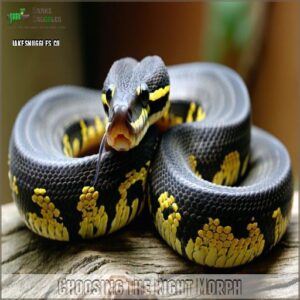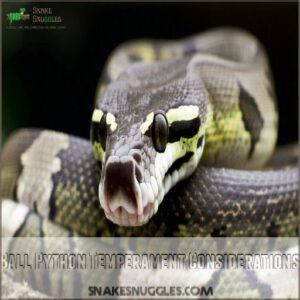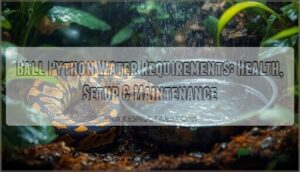This site is supported by our readers. We may earn a commission, at no cost to you, if you purchase through links.

Look for clear eyes and a nicely rounded body—no grimy scales allowed! A clean vent, injury-free skin, and active behavior are key signs of health.
Ask about its age, health history, and eating habits, just as you’d inquire about a potential new housemate’s quirks. Prices can vary wildly, from $50 to thousands, so know your budget.
Remember, a snake that’s as lively as your morning coffee is a good sign. And here’s a twist—discovering morphs might be your new obsession!
Table Of Contents
- Key Takeaways
- Where to Find a Ball Python
- Signs of a Healthy Ball Python
- Cost and Age Considerations
- Choosing The Right Morph
- Evaluating Feeding History
- Health Check and Veterinary Care
- Ball Python Temperament Considerations
- Researching The Breeder or Seller
- Preparing for a New Ball Python
- Bringing Your Ball Python Home
- Frequently Asked Questions (FAQs)
- How to know if ball python is healthy?
- What to look for when buying a ball python?
- How can you tell if a ball python is happy?
- When should you not pick up ball pythons?
- What are common beginner mistakes with ball pythons?
- How to identify and prevent stress in ball pythons?
- What is the legal process for owning a ball python?
- Can a ball pythons enclosure be eco-friendly?
- How does handling impact a ball pythons health?
- Conclusion
Key Takeaways
- Look for a reputable breeder or trustworthy pet store, checking for reviews, clear communication, and health guarantees to ensure a healthy ball python.
- Inspect the snake’s physical health by checking for clear eyes, smooth scales, a firm body, and alert behavior to confirm it is in good shape.
- Understand the feeding history and schedule to ensure your new snake has regular, healthy eating habits and a balanced diet.
- Prepare a suitable habitat with proper temperature, humidity, and hiding spots to create a comfortable, stress-free environment for your ball python.
Where to Find a Ball Python
You’re ready to bring home a ball python, but where do you start the search?
Consider checking out reputable breeders, trustworthy pet stores,
or even snake rescue organizations to find your new slithery friend.
Reputable Breeders
When choosing a ball python, reputable breeders are your best bet.
Seek those who offer facility tours and health guarantees.
Good breeders are open about their process, sharing details on lineage verification.
Check reviews to gauge their reputation.
Breeder ethics matter when picking your new friend.
You’ll guarantee responsible ball python ownership with a healthy, vibrant pet.
Trustworthy Pet Stores
Finding a healthy ball python at a pet store? Check the store’s reputation first!
Do the employees show genuine animal welfare knowledge?
Look for pricing transparency, with costs ranging from $50 to $60, and solid health guarantees, as you’d expect from a reputable ball python breeder.
A trustworthy store prioritizes healthy reptiles, making your ball python selection easier.
Responsible pet stores offer peace of mind when choosing a healthy ball python, ensuring your new pet enjoys a long, healthy life.
Snake Rescue Organizations
Consider adopting a ball python through a snake rescue organization.
These places often have a range of healthy reptiles needing homes, and their knowledgeable staff can guide you through the adoption process while ensuring ethical considerations.
Volunteering at a rescue offers a first-hand look at success stories, helping you select a healthy ball python with confidence.
Signs of a Healthy Ball Python
When picking a ball python, look for clear eyes and a rounded body to confirm it’s in top shape.
It’s a good sign if your potential pet is active and alert.
A clean vent and no injuries are also important. Just don’t expect them to wave hello!
Clear Eyes and Rounded Body
Spotting a healthy ball python isn’t rocket science. Look for these telltale signs:
- Eye Clarity: Eyes should be clear, not cloudy, unless they’re shedding.
- Body Condition: A rounded, firm body indicates good health.
- Weight: Verify they’re within a healthy weight range.
- Dehydration Signs: Watch for wrinkled skin or dry scales.
Clean Vent and No Injuries
Checking for a clean vent and no injuries is important when picking a healthy ball python. Think of it as a snake’s version of a check-up.
Make sure there’s no residue or swelling around the vent—this can signal health issues like parasites.
Also, inspect the skin closely for cuts or signs of poor shedding. Keeping an eye on these helps avoid potential ball python diseases.
Active and Alert Behavior
While a clean vent is essential, watch for a ball python that’s active and alert too. Here’s what to look for:
- Alertness levels: Your snake should perk up when you approach, and a quick glance at products for active ball pythons can help you understand how these signs of health are essential for a happy pet.
- Response to stimuli: They ought to react to touch and movement.
- Body posture: A relaxed yet responsive stance is key.
- Movement patterns: Smooth, deliberate motions signal health.
Cost and Age Considerations
When choosing your ball python, keep in mind that prices can range from $50 to thousands of dollars, depending on their unique colors and patterns.
Additionally, consider the snake’s age and health history to make certain you’re bringing home a healthy and affordable new friend.
Ball Python Price Range
So, you’re thinking about adding a ball python to your family?
A healthy ball python’s price varies quite a bit. You can often find them for between $50 and $100.
That’s a pretty affordable option for a pet that could live for decades!
Remember, this is just a general price range; the actual cost can change.
Factors Affecting Cost
When buying a ball python, several factors affect the cost.
Rarity and morph greatly impact the price—common morphs cost less, while rare ones fetch a premium.
Location can influence shipping fees or availability.
Breeder reputation also matters; trusted breeders may charge more for healthy ball pythons.
Keep these in mind to balance quality and budget.
Age and Health History
A healthy ball python’s age and health history are your roadmaps to a long-lasting companionship.
- Ask about past illnesses and genetic issues—they impact the snake’s long-term well-being.
- Check the breeder’s reputation for feeding records.
- Assess the growth rate; too fast or slow hints at problems.
- Make certain a balance between ball python age and health history for a thriving pet.
Choosing The Right Morph
Choosing the right ball python morph is like picking your favorite ice cream flavor—there are plenty of delightful options, from classic to rare varieties.
Whether you’re drawn to the vibrant colors of a banana morph or the subtle beauty of a pastel, it’s important to research their characteristics and costs.
to find the perfect match for you.
Common Ball Python Morphs
Beginning your ball python journey means exploring morph colors and genetic variations.
Common varieties like Pastel, Albino, and Pinstripe exhibit beautiful colors and patterns without breaking the bank.
These morphs provide beginners with affordable, ethically bred options that prioritize ball python health.
Explore these unique combinations and enjoy the striking beauty each morph adds to your scaly friend’s wardrobe.
Rare and Expensive Morphs
Rare and expensive ball python morphs can become the crown jewels of any collection, sparking both fascination and deep pockets. Unravel the unique beauty of these morphs, often fetching thousands due to their genetic traits and rarity.
- Morph rarity impacts cost.
- The collector market drives prices.
- Ethical breeding matters.
- Always verify breeder credibility.
- Genetic traits can influence health.
Researching Morph Characteristics
Knowing that rare morphs can be enchanting, explore researching morph genetics and learn about ball python morphs like color and pattern differences.
Keep an eye on how these traits affect both price and health implications.
Ask a breeder about any ethical concerns with breeding certain morphs.
This guarantees a smart purchase and a healthy pet.
Evaluating Feeding History
A healthy appetite is key to a happy snake.
Don’t be shy about asking the breeder or seller about your potential pet’s feeding history.
Understanding their eating habits will help you choose a thriving ball python and avoid future feeding frustrations.
Importance of Feeding History
Understanding a ball python’s feeding history is essential for your snake’s health.
Regular feeding habits, such as following a snake feeding schedule chart, show it’s used to a balanced diet, ensuring proper growth and reducing health issues.
Check prey size and feeding intervals to prevent regurgitation and refusal.
This background helps anticipate any curves your new pet might throw your way, securing a smoother start together.
Identifying Feeding Issues
Spotting feeding issues in ball pythons can feel challenging, but it’s manageable with the right approach.
Watch for:
- Food refusal: Could be stress or illness.
- Prey size errors: Too large prey causes regurgitation.
- Seasonal fasting: Normal during colder months.
- Health issues: Consistent refusal might hint at underlying problems.
- Unexpected behavior: A change in feeding appetite warrants attention.
Asking About Feeding Schedule
Asking about the feeding schedule gives insight into your ball python’s habits and history.
A regular feeding frequency affects their health and appetite over time.
Here’s what to think about:
| Feeding Frequency | Prey Size | Potential Issue |
|---|---|---|
| Weekly | Matched | Supports health |
| Seasonal | Varied | Possible fasting |
| Inconsistent | Mismatched | Food refusal risks |
Learning these details helps maintain your snake’s well-being.
Health Check and Veterinary Care
Ensuring your ball python’s health starts with a thorough initial check-up.
Regular veterinary visits are important to catch any sneaky snake ailments before they slither into bigger issues!
Initial Health Check
Before bringing your ball python home, a thorough health check is key!
Start by examining its body condition and scale condition—both should be smooth and firm.
Check eye clarity and look out for any nasal discharge.
Notice its respiratory rate for signs of trouble.
Ensuring good reptile health prevents future ball python health issues, making your vet’s job easier!
Regular Veterinary Checkups
A regular visit to the vet is gold for your ball python’s health. Early detection of issues like respiratory infections can make all the difference.
Here’s your checklist:
- Parasite Checks: Keep those pesky invaders at bay with routine screenings.
- IBD Screening: Catch this silent threat early and guarantee safety.
- Respiratory and Shedding Issues: Your vet can spot problems you’re likely to miss, making preventative care a smooth sail.
Identifying Potential Health Issues
Regular vet checkups are your best friend.
Keep an eye out for anything unusual; sneezing could mean a respiratory infection. Shedding problems? That’s dysecdysis.
Is your ball python acting strangely? Changes in feeding or behavior could signal a problem.
Don’t forget about parasites! Early detection is key for things like IBD. A healthy snake is a happy snake—and a happy owner!
Ball Python Temperament Considerations
When picking a ball python, you’ll want to check its temperament.
to make sure it’s a good fit for your home.
Look for a snake that’s calm and curious, not one that’s ready to star in a horror movie!
Handling and Temperament
Handling your ball python is like a waltz—gentle moves work best.
Begin by establishing a routine:
- Support its body entirely with both hands.
- Avoid sudden moves to prevent anxiety.
- Wait a week post-arrival and give it time to get cozy.
- Handle weekly to build trust and encourage socialization.
Engage often, but gently.
Signs of Stress and Fear
Imagine this: your ball python suddenly curls into a tight ball or starts hissing like a tiny steam engine. These body language cues signal stress.
Watch for changes in hiding behavior or appetite, as these are key indicators of discomfort.
Defensive postures might look intimidating, but they’re your snake’s way of shouting, "Back off!" Stay alert to maintain their well-being.
Choosing a Snake With a Good Temperament
Spotting stress signs is key.
Choosing a ball python with a good temperament truly sets the stage for bonding. Look for one that shows a calm response during handling.
Smooth interactions often predict easy socialization.
Think of your new friend as a puzzle piece fitting perfectly into your life, where both handling techniques and happiness align.
Researching The Breeder or Seller
When you’re on the hunt for a new ball python, it’s essential to check out the breeder or seller’s reputation to avoid snake-related dramas.
Look for breeders known for healthy snakes and good practices.
Steer clear of any sketchy situations that make you second-guess your choice.
Reputable Breeder Characteristics
When you’re scouting for a professional breeder, look for one with years of experience and ethical practices.
Make sure they offer health guarantees and prioritize facility cleanliness.
An ideal breeder shows the parent lineage of their ball pythons, addressing any potential health concerns.
This approach guarantees your ball python’s purchase is informed, paving the way for healthy, happy ownership.
Red Flags to Watch Out For
So, you’ve found a breeder who seems great. But before you hand over your cash, watch out for these red flags:
- Lethargic behavior in their snakes.
- Dull eyes or skin issues.
- Unexpected weight loss.
- Any unusual discharge.
These could signal underlying ball python health concerns, so always trust your gut and seek a ball python vet if something feels off.
A healthy snake is a happy snake!
Preparing for a New Ball Python
Before your new ball python moves in, make sure its enclosure is as cozy as a hotel for a long-term guest.
Understanding their care basics and setting up a feeding schedule will keep your slithery friend healthy and happy.
Preparing The Enclosure
You’ve picked your perfect python, and now it’s time to nail the right setup.
To get started, you might find helpful resources and supplies for building the perfect enclosure at this online retailer.
Consider a roomy tank—start with at least 40 gallons for younger snakes. Choose cozy substrates like aspen or coconut coir.
Balance is key: maintain temperature gradients and 60-70% humidity.
Snakes love hideouts, so throw in a couple to make your new friend comfortable.
Understanding Ball Python Care
Understanding ball python care is like having a low-maintenance roommate who sometimes hides in their room. Once your enclosure setup’s ready, focus on their comfort and wellbeing.
- Temperature and Humidity: Maintain 88-92°F on the warm side and 60-70% humidity.
- Substrate: Try aspen shavings or coconut coir.
- Hides: Provide at least two cozy spots.
- Health Monitoring: Regular check-ups guarantee a happy snake.
Setting Up a Feeding Schedule
Got your new ball python all set up? Now, let’s talk feeding.
Choose the right prey size—match it to your snake’s width.
Consider the age and size of your ball python to determine its specific ball python feeding schedule.
Follow a regular feeding schedule: every 5-7 days for young ones, 10-14 for adults.
Defrost rodents thoroughly.
If they refuse food, don’t panic. Make certain a calm feeding environment, avoiding stress to prevent any ball python health concerns.
Bringing Your Ball Python Home
When you bring your ball python home, make its journey smooth by using a secure, ventilated container to prevent any surprises on the road.
Once settled in its new habitat, keep an eye on your snake’s behavior to make sure it adjusts comfortably and stays healthy.
Safe Transportation
Safe transportation of your ball python is like setting sail with a treasured cargo—it’s all about preparation.
- Use a secure container with ventilation.
- Control the climate to keep it comfortable.
- Limit sudden movements to minimize stress.
- Have an arrival checklist for immediate needs.
- Stay calm, ensuring your ball python feels secure during its journey.
Acclimating Your Snake to Its New Home
Once home, settle your new ball python in its quiet space.
Confirming proper housing conditions such as a temperature gradient of 76-92°F and humidity around 55-60% as outlined in Ball Python Housing Tips.
Avoid handling for a week; let it adjust to its new environment, proper heating, and humidity control.
Gradual handling helps prevent ball python stress.
Remember, a calm introduction is key to successful ball python acclimation and socialization.
Patience guarantees a healthy start!
Monitoring Your Snake’s Adjustment
Adjusting to a new home is a journey, even for your ball python. Keep an eye on:
- Initial feeding response – Eating is a positive sign.
- Activity levels – Are they cruising or hiding?
- Overall behavior – Any stress or calmness noticed?
To track weight changes accurately, consider investing in a reliable ball python weight scale.
- Weight changes – Is there consistent weight?
Swift action can prevent issues, so stay alert!
Frequently Asked Questions (FAQs)
How to know if ball python is healthy?
To check if your ball python is healthy, look for clear eyes, rounded body, and clean, injury-free skin.
It should be alert and responsive.
It should be breathing smoothly and have a steady weight with no signs of respiratory issues.
What to look for when buying a ball python?
When buying a ball python, check for clear eyes, smooth scales, and a firm body.
Make sure it’s alert, not lethargic.
Also, inquire about its feeding history and verify there’s no sign of respiratory issues.
How can you tell if a ball python is happy?
A happy ball python actively explores its enclosure, eats readily, sheds smoothly, and shows no signs of illness. It’s alert, curious, and generally relaxed. If it’s hiding constantly, something’s amiss!
When should you not pick up ball pythons?
Imagine this: you’re about to snuggle your python, but it recently ate or is shedding.
It’s best to wait.
Disturbing it now might stress it, like interrupting someone’s post-dinner nap. Be patient!
What are common beginner mistakes with ball pythons?
Overfeeding, poor tank setup, and handling too soon after feeding are classic beginner errors with ball pythons.
Make sure you provide a proper habitat, manage handling carefully, and observe feeding schedules to maintain their health and comfort.
ball pythons
How to identify and prevent stress in ball pythons?
Spotting a stressed ball python is easier than finding a needle in a haystack. Look for signs like excessive hiding, hissing, or striking.
Prevent stress by maintaining proper habitat conditions, gentle handling, and providing hiding spots.
What is the legal process for owning a ball python?
To legally own a ball python, check local wildlife laws and regulations.
Obtain the necessary permits if required.
Purchase from a reputable source, and provide proper care to meet legal and ethical standards for exotic pets.
Can a ball pythons enclosure be eco-friendly?
Think of your ball python’s enclosure as a mini ecosystem.
Use renewable materials like sustainably sourced wood for structures.
Use live plants for décor, and eco-friendly substrates like coconut husk.
Create a green, energy-efficient habitat.
How does handling impact a ball pythons health?
Handling your ball python regularly helps it feel comfortable and reduces stress, aiding in overall health.
Just don’t handle right after meals, or you might end up with a suddenly more slippery snake than anticipated!
Conclusion
So, you’re ready to welcome a scaly friend into your life! Choosing a healthy ball python is like picking the perfect piece of art—it takes time and attention to detail.
Remember those key steps: find a reputable source, check for bright eyes and a healthy body, and ask about its history.
Don’t forget to research morphs and their care needs. A little prep work now means years of happy companionship with your new pet.
Choosing a healthy ball python is an investment in a long and rewarding friendship! This is key




















